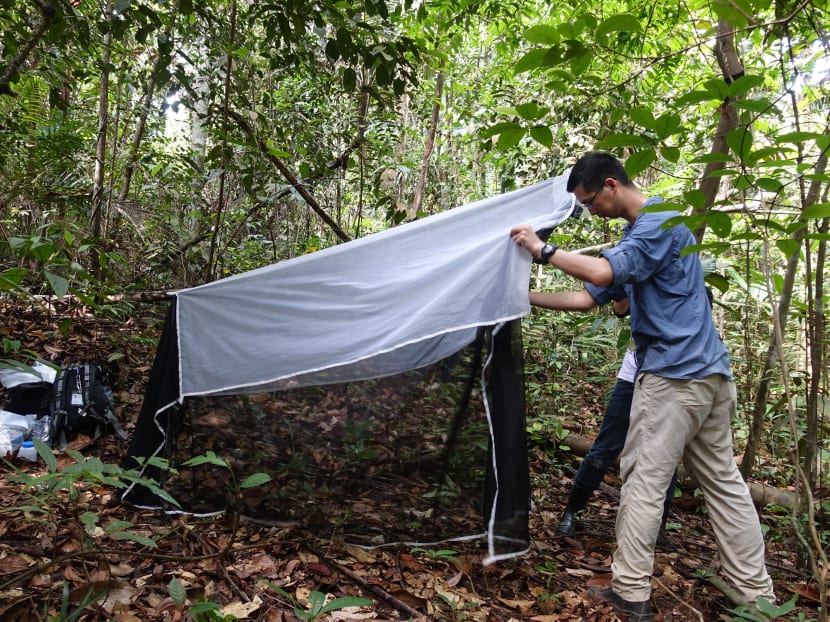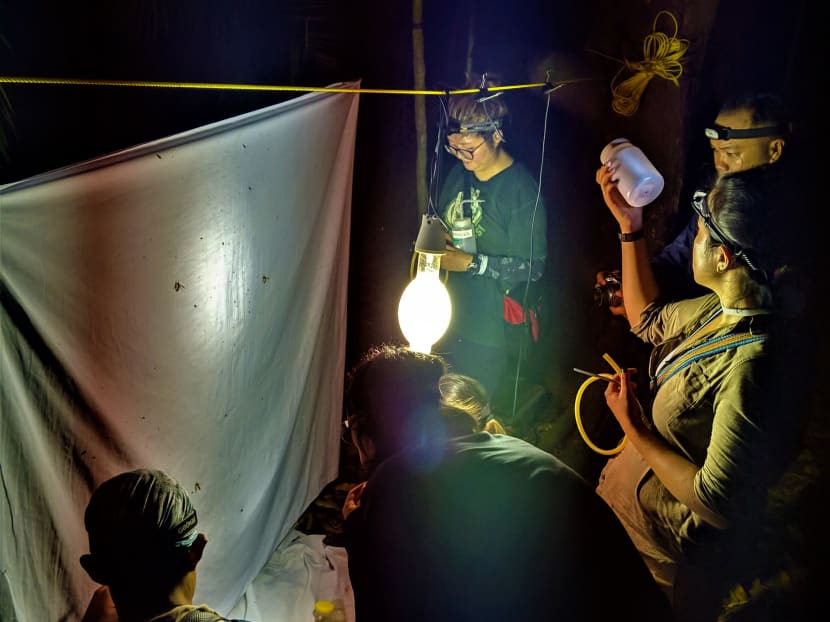Love chocolate? Thank insects, say researchers who get cash boost to study Mandai creepy crawlies
SINGAPORE — Most people go out of their way to avoid creepy crawlies. But a team of researchers, bolstered by a slice of S$600,000 of fresh funding from the Mandai Research Fund, is aiming to study up close every type of insect in the Mandai area.

This tent-like "malaise" trap being set up for insect sampling in the Mandai area. The traps are generally placed in a flyway where they can sample a good representation of insects over a week.
SINGAPORE — Most people go out of their way to avoid creepy crawlies. But a team of researchers, bolstered by a slice of S$600,000 of fresh funding from the Mandai Research Fund, is aiming to study up close every type of insect in the Mandai area.
The two-year study is one of four scientific projects to receive largesse from the fund, which is being disbursed over two years by Mandai Park Development (MPD), the body that oversees development of the precinct, including a new resort, as well as the Singapore Zoo, Night Safari and River Safari.
Dr Hwang Wei Song, the principal investigator of the Mandai insect survey, said on Monday (July 29) that it will study the insect population of the Mandai secondary forest and their possible impact on public health and the environment.
When the resort opens in 2023, it will be useful to have the information on hand to know which insects could pose public health hazards, he said. “If anything sprouts out later on, they can also check back and see if this (insect) is something that is inherently here, or it was brought in (unintentionally).”
The data will also allow for the devising of appropriate mitigation measures, said Dr Hwang, the curator of the Entomological Collections at the Lee Kong Chian Natural History Museum, National University of Singapore.
Field sampling for Dr Hwang’s project, called “Pollinators, decomposers and blood-suckers”, which commenced in late January this year, will continue until the end of the year.
After that, researchers will proceed with imaging, sequencing, specimen curation and data analysis for selected species.

To sample insects of varying sizes, the team uses an assortment of equipment for optimal data collection. Photo: Mandai Park Holdings
By the end of their study in 2021, Dr Hwang and his team will have created an inventory list of the insect diversity present in the buffer zones and the retained forests within the Mandai development project area.
Information on the species found will also be uploaded for the public on the Biodiversity of Singapore website.
The other three projects will revolve around research on thermal comfort, the impact of Mandai developments on movements of the Sunda colugo, also known as the flying lemur, and managing carnivore dung with black soldier flies.
Dr Lee Hui Mien, MPD’s vice president for sustainable solutions, said that the research will allow them to identify knowledge gaps and delve deeper into “specific issues which may be unique” to the Mandai district.
She added that new data collected could also add to the scientific advancement of Singapore’s biodiversity knowledge.
MAINTAINING A DELICATE BALANCE
Dr Hwang said the Republic may have lost a number of big animals, but the areas of forest that remain are still very rich in biodiversity. “We are still finding new species here. We are still finding new records as well, species that were identified elsewhere (around the world) that we didn’t know we had.”
Fellow researcher and curator Dr Ang Yuchen added that about 80 to 90 per cent of Singapore’s biodiversity consists of insects.
While the presence of some species may be a cause for concern, others play an “important service” to the environment which humans often take for granted.
“They are the cleaners (of the environment) and they are the pollinators. Without insects, such as a certain fly, you will not have chocolate,” said Dr Ang. The fly, a biting midge, pollinates the tiny flower of the cacao plant.
Insects such as the assassin bug also help to prevent the overpopulation of other creatures such as spiders or caterpillars.
Left unchecked, large numbers of these creatures could have a negative cascading effect on the environment.
Dr Ang said that insects provide a snapshot of what is happening in the forest. “One of the easiest ways to find out about the health of the ecosystem is just to sample the insects. It’s basically like our immune system.”
He said: “If you have a lot of one species, you know that place is in trouble because there is no balance any more.”

The research team samples nocturnal insects through the use of mercury-vapour light. Photo: Mandai Park Holdings
Dr Ang is worried that this delicate balance might become upset through a combination of pest-control measures, such as fogging, and invasive species of insects that could oust their native counterparts.
“All the ecosystem functions that were originally being supported by the bigger mammals like tigers and deers are all gone. The only thing that is just supporting it are insects, and they are being hammered left, right, centre.”








